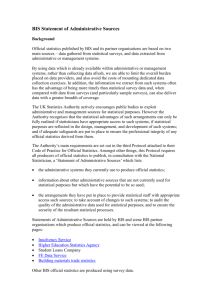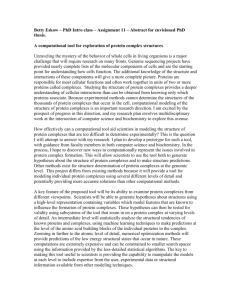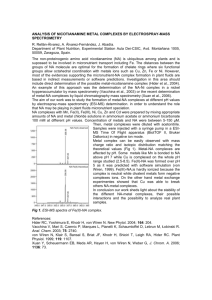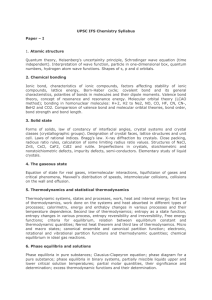Structural Studies of 2,6-diacetyl - Werner Kaminsky
advertisement
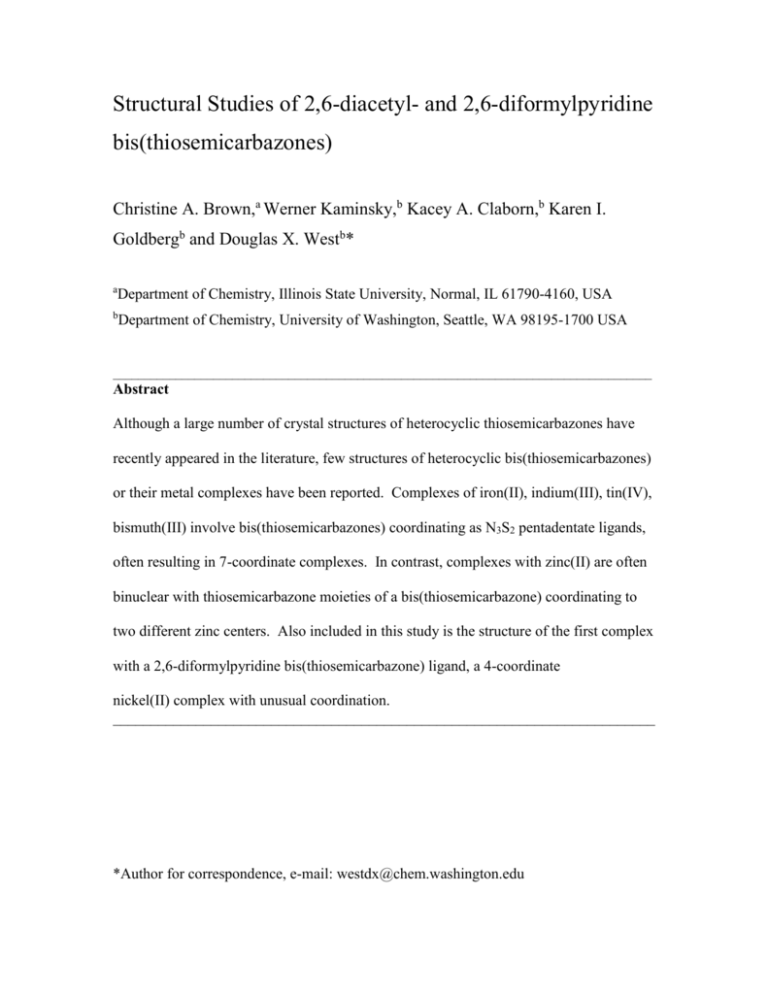
Structural Studies of 2,6-diacetyl- and 2,6-diformylpyridine
bis(thiosemicarbazones)
Christine A. Brown,a Werner Kaminsky,b Kacey A. Claborn,b Karen I.
Goldbergb and Douglas X. Westb*
a
Department of Chemistry, Illinois State University, Normal, IL 61790-4160, USA
b
Department of Chemistry, University of Washington, Seattle, WA 98195-1700 USA
______________________________________________________________________________________
Abstract
Although a large number of crystal structures of heterocyclic thiosemicarbazones have
recently appeared in the literature, few structures of heterocyclic bis(thiosemicarbazones)
or their metal complexes have been reported. Complexes of iron(II), indium(III), tin(IV),
bismuth(III) involve bis(thiosemicarbazones) coordinating as N3S2 pentadentate ligands,
often resulting in 7-coordinate complexes. In contrast, complexes with zinc(II) are often
binuclear with thiosemicarbazone moieties of a bis(thiosemicarbazone) coordinating to
two different zinc centers. Also included in this study is the structure of the first complex
with a 2,6-diformylpyridine bis(thiosemicarbazone) ligand, a 4-coordinate
nickel(II) complex with unusual coordination.
________________________________________________________________________
*Author for correspondence, e-mail: westdx@chem.washington.edu
2
Introduction
Heterocyclic thiosemicarbazones capable of tridentate coordination have been
studied extensively,1-5 and in recent years many reports involve crystal structures of these
thiosemicarbazones and/or their metal complexes.6 Also, the structures of
bis(thiosemicarbazones) capable of tetradentate coordination and their complexes have
been the subject of numerous recent reports.7-22 However, less attention has been given
to heterocyclic bis(thiosemicarbazones), Figure 1 (numbering scheme for nitrogens in
Figure 1 is used throughout this report), which are capable of higher denticity. This is
particularly true for those heterocyclic bis(thiosemicarbazones) with substituents other
than NH2 in the N4-position of the thiosemicarbazone moiety. Spectral and biological
studies have been carried out on metal complexes of 2,6-diacetylpyridine bis(N4substituted thiosemicarbazones).23-25 Structural information for a heterocyclic bis(N4substituted thiosemicarbazone) has only recently been reported26 even though the N4substituent(s) in other types of thiosemicarbazones, including bis(thiosemicarbazones),
has been shown to significantly affect their biological activity.25 The structural study of
heterocyclic bis(thiosemicarbazones) and their metal complexes is the subject of this
contribution, which is not exhaustive, but representative of this area of chemistry at this
writing. Included is the structure of a new nickel(II) complex of a 2,6-diformylpyridine
bis{N(4)-dimethylthiosemicarbazone}, [Ni(2,6Fo4DM)]; we believe this is the first
complex of a 2,6-diformylpyridine bis(thiosemicarbazone) to be reported.
Figure 1
Structural studies of the heterocyclic bis(thiosemicarbazones)
3
Only recently has the crystal structure of a heterocyclic N4-substituted
bis(thiosemicarbazone) been reported26 even though a number of heterocyclic N4substituted thiosemicarbazones have been shown to exist in as many as 4 different
structural forms.27,28 Bright yellow 2,6-diacetylpyridine bis(3-hexamethyleneiminylthiosemicarbazone) monohydrate, H22,6Achexim.H2O, was grown from EtOH and
crystallized in the orthorhombic Pbcn space group with 8 molecules in the unit cell. One
thiosemicarbazone moiety is in the E conformation with respect to the C-N (imine) bond
and the N3H is hydrogen bonding to the hydrate water molecule, Figure 2. The second
thiosemicarbazone moiety has what is normally the N3 hydrogen shifted to N2 and
involved in a bifurcated hydrogen bond with the pyridine nitrogen and thiolato sulfur.
This tautomeric form of a thiosemicarbazone moiety with formal charges on N2 and S,
designated E’, has been found for 2-acetylpyridine N(4)-dialkyl- and 3azacyclothiosemicarbazones,27 and, more recently, for 2-pyridineformamide N(4)-dialkyland 3-azacyclothiosemicarbazones.29 Evidence for the different forms of the two
thiosemicarbazone moieties is the difference in the following bonds: E moiety: C-N2,
1.313(7) Å; N2-N3, 1.372(7), Å; C-S, 1.689(7) Å and E’ moiety: C-N2, 1.291(6) Å; N2N3, 1.347(6); C-S, 1.716(6) Å. The bond angles of the thiosemicarbazone moieties show
even greater differences.
Structural studies of the metal complexes of heterocyclic bis(thiosemicarbazones)
Iron(II) complexes
The first transition metal complex of a heterocyclic bis(thiosemicarbazone)
reported was an iron(II) complex, [Fe(H22,6Ac4DH)(NCS)2], where H22,6Ac4DH is 2,6diacetylpyridine bis(thiosemicarbazone).30 The complex, which crystallized in the
4
tetragonal P41212 space group with 4 molecules in the unit cell, is an approximate
pentagonal bipyramid with the N-thiocyanato ligands in the apical positions, Figure 3.
The NCS groups are linear with FeNC angles of 178.7(7)º and interact with the water of
crystallization (non-bonding O…SCN distance of 3.4 Å). It should be noted that this
complex was obtained by reacting iron(III) with H22,6Ac4DH. Although a number of
other transition metal complexes have been prepared and tested for biological activity,31
to our knowledge no other crystal structures have been reported. However, structures of
transition metal complexes with 2,6-diacetylpyridine bis(semicarbazone) continue to be
an area of study.32
Indium(III) complexes
Two complexes involving the monoanion (i.e., one of the thiosemicarbazone
moieties has lost a N3H) of 2,6-diacetylpyridine bis(thiosemicarbazone), H22,6Ac4DH,
are included in a recent article.33 Crystals of [In(H2,6Ac4DH)Cl2].DMSO, which is
sparingly soluble in most solvents, were obtained by dissolution in boiling dimethyl
sulfoxide followed by cooling the solution at 10º/hr. The complex has monoanionic
H2,6Ac4DH coordinating as a pentadentate ligand via the pyridine nitrogen, two imine
nitrogen and the thione and thiolato sulfur atoms with chloro ligands in the apical
positions of an approximate pentagonal bipyramid, Figure 2. This complex provides a
comparison of two different thiosemicarbazone moieties in the same complex. It should
be noted that there are several complexes with heterocyclic tridentate thiosemicarbazone
ligands that have two forms of different charge attached to the same metal,34,35 as well as
inequivalent coordination of the same form.36 Listed in Table 1 are selected bond
distances for the two forms, and there is considerable difference. Bonds to indium(III)
5
for the anionic thiosemicarbazone moiety are shorter than those of the neutral moiety.
The thione C-S bond in the neutral moiety remains a formal double bond making it
shorter than the C-S bond of the anionic moiety, and the N3-C bond, Fig.1, which
formally becomes a double bond in the anionic moiety, is longer in the neutral moiety.
The In-Npy bond is 2.330(5) Å, the apical chloro distances differ somewhat, 2.497(2) and
2.535(2) Å, and the Cl-In-Cl angle is 166.02(5)º indicating significant distortion from a
regular stereochemistry.
An interesting second complex with the monoanionic bis(thiosemicarbazone) of
2,6-diacetylpyridine was prepared with In(NO3)3.5H2O.33 With monoanionic
H2,6Ac4DH coordinating as a planar pentadentate ligand as in [In(H2,6Ac4DH)Cl2],
{O[In(H2,6Ac4DH)(OH)]2}.5MeOH consists of two In(III) centers bridged by an oxido
ligand and hydroxo ligands at the terminal, apical positions. As shown in Fig.2, the two
In(III) centers are rotated ca. 180º to each other, the In-O bonds are about 0.1 Å shorter
than the In-OH bonds and the In-O-In angle is 179.8(5)º. It was not possible to locate all
of the hydrogens in the final Fourier map, but the differences in bond distances in the
anionic and neutral thiosemicarbazone moieties are similar to those of
[In(H2,6Ac4DH)Cl2].
Tin(IV) complexes
Complexes of the unsubstituted 2,6-diacetylpyridine bis(thiosemicarbazone),
H22,6Ac4DH, have received considerable attention and a number of 7-coordinate tin(IV)
complexes have been reported. Neutral complexes with the dianionic
bis(thiosemicarbazone) and cationic complexes with the monoanionic
6
thiosemicarbazone/thiosemicarbazonato ligand (i.e., only one of the moieties loses N3H)
are formed and 2,6Ac4DH and H2,6Ac4DH both coordinate about the Sn in an
approximate pentagonal plane. Two apical positions are occupied by monodentate aryl,
alkyl or halo ligands and raise the coordination number to seven for approximate
pentagonal bipyramids. The bond distances involving tin(IV) and the
bis(thiosemicarbazone) ligands are listed in Table 2 for the complexes discussed below.
Neutral tin(IV) complexes
[Sn(2,6Ac4DH)Ph2].2DMF crystallized in the P21/n space group with Z = 4 and
solved to a very good R value of 0.035.37 The following summarizes the distortion from
regular stereochemistry: the Sn(IV) center is displaced from the basal plane (average
deviation is 0.027 Å) by 0.021(1) Å, the C-Sn-C angle is 166.9(2)º and the mean planes
of the phenyl rings are 28.8(2) º from each other. Hydrogen bonding interactions by
N4H2 to the DMF oxygen have the following parameters: N-H…O, 2.847(6) Å; H…O,
1.92(9) Å, and N-H…O, 158.9(8)º for one interaction and N-H…O, 2.867(7) Å;
H…O, 1.986(5) Å, and N-H…O, 153.7(6)º.
Crystals of the 7-coordinate neutral complex, [Sn(2,6Achexim)Bu2] (2,6Achexim
is the dianion of 2,6-diacetylpyridine 3-hexamethyleneiminylthiosemicarbazone),26 were
grown by slow evaporation of EtOH, and the structure is again an approximate
pentagonal bipyramid. The structure was solved as orthorhombic Pnma symmetry group
with Z = 4. The axial butyl groups contribute to the distortion since the C-Sn-C angle is
171.6(4)°. The tin(IV) is 0.008(3) Å out of the plane of the pentagonal ring, S-N2-NpyN2-S (mean deviation 0.0751 Å). Coordination to the tin(IV) center by the imine
nitrogen and the thiolato sulfur lengthens N2-C to 1.331(7) Å, as well as S-C to 1.746(7)
7
Å, from an average of 1.302(7) Å and 1.703(7) Å, respectively, in H22,6Achexim.H2O.
One of the butyl groups shows considerable disorder and contributes to the relatively
high R-value, 0.0540.
Cationic tin(IV) complexes
Crystals of [Sn(H2,6Ac4DH)(Me)Cl]Cl.MeOH38 were acquired by slow
evaporation of the preparative solution, and the structure was solved to be monoclinic
P21/c with Z = 4. With the monoanionic ligand this is another complex that provides an
interesting contrast between its two thiosemicarbazone moieties, as well as tin(IV)
complexes with dianionic 2,6Ac4DH. Tin(IV)-ligand bond distances, Table 2, are listed
together for the two moieties to allow easy comparison. Also included in this article is
the bis(semicarbazone) complex, [Sn(2,6AcO4DH)(Me)Cl], which has the following
bond distances: Sn-N(Py) = 2.262(2) Å and Sn-N(im) = 2.284(7) and 2.252(7) Å.
Yellow [Sn(H2,6Ac4DH)Ph2]Cl crystallizes from dry methanol in the P21/n
symmetry group with four formula units per unit cell.39 The anionic pentadentate ligand
coordinates as discussed above and the bond distances are listed in Table 2. The SnC(phenyl) distances are 2.163(4) and 2.170(4) Å and the two phenyl rings form an angle
between their mean planes of 44.4(3)°, which is significantly larger than found for
[Sn(2,6Ac4DH)Ph2]37 discussed previously. The thiolato C-S bond distance, 1,731(5) Å,
is significantly longer than the thione C-S distance, 1.694(6) Å, and the imine C-N2
(anionic moiety) = 1,346(6) Å compared to the neutral moiety’s 1.290(6) Å, again
indicating significant differences between the two moieties. The chloride counterion
interacts with the complex through hydrogen bonds, the remaining N3H forming the
strongest interaction: N-H…Cl, 3.071(5) Å; H…Cl, 2.24(7) Å; NH…Cl, 157(6)°. One
8
hydrogen attached to N4 interacts more weakly with the chloride counterion: : N-H…Cl,
3.216(7) Å; H…Cl, 2.44(7) Å; NH…Cl, 150(6)° and the other N4 hydrogen, as well as
the anionic moiety’s N4H2, interact with chlorides of other formula units.
Bismuth(III) complexes
Reaction between BiCl3 and H22,6Ac4DH in acetone, evaporation to dryness
followed by dissolution of the powder in DMSO, addition of excess NaN3 and slow
evaporation of this solution produced red crystals of [Bi(2,6Ac4DH)(N3)].0.5DMSO,
P21/n and Z = 2.40 2,6Ac4DH coordinates via the usual pyridyl nitrogen, imine nitrogen
and thiolato sulfur atoms and the essentially linear azido ligand, N-N-N = 178(3)°,
brings the coordination number to 6 resulting in an approximate pentagonal pyramid
structure. The azido ligand coordinates in the expected fashion with Bi-N-N = 121(1)°.
Bi-S bond distances are 2.717(8) and 2.685(7) Å, Bi-N(imine) = 2.58(2) and 2.46(2) Å
and Bi-N(pyridine) is listed as 2.44(2) Å although it would seem based on other
complexes of 2,6Ac4DH that this value should be longer (e.g., 2.58(2) Å). The BiN(azido) distance 2.25(2) Å. The packing of the molecules is by means of contacts with
the other terminal nitrogen of the azido ligand and the unoccupied apical position on the
Bi of an adjacent molecule.
Zinc(II) complexes
Like zinc complexes of the 2,6-diacetylpyridine bis(semicarbazone),41 heterocyclic
bis(thiosemicarbazone) complexes with zinc show greater variation in their mode of
coordination than the previously discussed complexes. For example, an early article42
9
contains structures of both mononuclear and binuclear zinc complexes with two different
modifications of the latter.
Mononuclear zinc(II) complexes
[Zn(H22,6Ac4DH)(H2O)2](NO3)2, an approximate pentagonal bipyramid complex
with a neutral bis(thiosemicarbazone) ligand, was obtained from methanol-nitric acid
solution and crystallizes in the monoclinic Cc space group with four molecules in the unit
cell.42 The neutral pentadentate ligand is approximately planar; the imine nitrogens, N2,
show the greatest deviation from planarity. Interestingly, the average Zn-S distance,
2.580(3) Å, is shorter than the Fe-S distance, 2.639(4) Å, of [Fe(H22,6Ac4DH)(NCS)2].30
Binuclear zinc(II) complexes
Two binuclear zinc(II) complexes were reported in the same article.42 One of the
complexes, [Zn(2,6Ac4DH)]2.MeOH.2DMF, features two zinc centers reported to have
distorted octahedral symmetry, Figure 4a. This complex crystallizes from DMF in the
monoclinic C2/c space group with four molecules in the unit cell, but only half a
[Zn(2,6Ac4DH)]2 in the assymmetric unit with the other half related to it by a
crystallographic two-fold axis. Each zinc atom in the biunuclear complex is coordinated
to two sulfur and two nitrogen (N2) atoms from two different 2,6Ac4DH ligands. The
two pyridine nitrogens have weak interactions that “bridge” the zinc centers of the
binuclear unit to bring the coordination number to six. The pyridine nitrogens are closer
to one zinc, 2.571(4) Å, than the other, 2.705(5) Å and the Zn-N-Zn angle is 94.2(2)º
with a Zn---Zn separation of 3.866(1) Å. The other Zn-ligand bond distances are listed in
Table 3, and it appears based on the other complexes that “coordination” of the pyridine
nitrogens could be described as a weak interaction and that the two zinc centers could be
10
considered as 5-coordinate, or even 4-coordinate. The S-Zn-S angle is 110.75(7)º
suggesting tetrahedral symmetry, but the N2-Zn-N2 angle is 152.5(1)º, more consistent
with distorted octahedral or trigonal bipyramid symmetry (i.e., N2’s in apical positions).
This same complex was reported by another group with essentially the same structural
characteristics a few years later.43
A second binuclear complex, [Zn(2,6Ac4DH)]2.MeOH.H2O, is a structural isomer
of the aforementioned [Zn(2,6Ac4DH)]2.MeOH.2DMF in terms of the zinc centers.42
One zinc atom is coordinated to two sulfur and four nitrogen donors (i.e., 2 N2 (imine)
and 2 inequivalently coordinated pyridine nitrogen atoms, Table 3) in a distorted
octahedral arrangement, Fig. 4b. The second zinc is coordinated to two sulfur and two
imine nitrogen donors in a distorted tetrahedral arrangement (i.e., the pyridine nitrogens
are 2.737(9) and 2.909(9) from this zinc center). [Zn(2,6Ac4DH)]2.MeOH.H2O
crystallizes from methanol in the triclinic P-1 space group with two molecules per unit
cell and has a rather large R value of 0.070. The N2-Zn-N2 angle for the “octahedral
zinc” is 169.5(4)º, which is larger than analogous angle, 154.61(18)º, found for
octahedral bis(2-pyridineformamide 3-piperidylthiosemicarbazonato)zinc(II).29 The
tetrahedral zinc center has S-Zn-S and N2-Zn-N2 angles of 118.3(2) and 140.8(4)º, which
are not very different from the “octahedral” center of [Zn(2,6Ac4DH)]2.MeOH.2DMF.
The other two angles that involve the N2-N3-C-S-Zn chelate rings, the N2-Zn-S angles,
are 111.6(4) and 120.8(3)º.
The bonding in [Zn(2,6Achexim)]2, which crystallized from ethanol in the P2/c
symmetry group with Z = 4, is described as distorted tetrahedral stereochemistry about
the two zinc centers, which are equivalent.26 The bond distances for the Zn-ligand bonds
11
are listed in Table 3 and the structure appears to be similar to
[Zn(2,6Ac4DH)]2.MeOH.2DMF,42 which was considered to have octahedral
coordination. A comparison of the bond angles for the two complexes shows the
following: [Zn(2,6Ac4DH)]2.MeOH.2DMF, S-Zn-S, 110.75(7)º; N2-Zn-N2, 152.5(1)º
and [Zn(2,6Achexim)]2, S-Zn-S, 114.6(1)º; N2-Zn-N2, 159.2(2)º. The Zn-S bond
distances are the same in the two complexes, but Zn-N2 is shorter in [Zn(2,6Achexim)]2,
and is even shorter than found for the tetrahedral zinc in [Zn(2,6Ac4DH)]2.MeOH.H2O.42
The crystal structure of a second binuclear zinc complex with a heterocyclic
bis(N4-substituted thiosemicarbazone), [Zn(Ac4DM)]2.1/2MeCN, where Ac4DM is the
dianion of 2,6-diacetylpyridine bis(N4-dimethylthiosemicarbazone), has recently
appeared.44 This complex was prepared by electrochemical oxidation of metallic zinc in
an acetonitrile solution of H22,6Ac4DM. The symmetry group is C2/c with 4 molecules
in the unit cell. Like [Zn(2,6Ac4DH)]2.MeOH.H2O42 this complex has octahedral and
tetrahedral zinc centers, but both are much more symmetrical for [Zn(Ac4DM)]2, Table
3. Consistent with more regular octahedral coordination is the N2-Zn-N2 angle,
176.6(4)º, and the two bond distances for Zn-Npy, Zn-N2 and Zn-S are identical.
Similarly, the Zn-N2 and Zn-S bond distances are equivalent for the tetrahedral
symmetry. The S-Zn-S and N2-Zn-N2 bond angles are 99.93(13) and 135.2(4)º,
respectively.
Nickel(II) complexes
We include here the first example of a metal complex with the dianion of a 2,6diformylpyridine bis(N4-dimethylthiosemicarbazone) ligand, [Ni(2,6Fo4DM)], Fig. 5,
which was grown from a 1:1 by volume mixture of methanol and acetonitrile. The
12
crystal was mounted on a glass fiber and used for data collection on a Nonius CCD
automatic diffractometer, MoK ( = 0.71073 Å). The structure was solved with direct
methods and missing atoms were found by difference-Fourier synthesis. All nonhydrogen atoms were refined with anisotropic temperature factors and the hydrogens,
except for the methyl hydrogens, were found on the difference map and refined
isotropically. The methyl hydrogens were fixed at d = 0.96 Å, allowed to ride on the C
atoms and assigned fixed isotropic temperature factor, U = 0.05 Å2. Refinement of the
structures was made by full-matrix least-squares on F2. Scattering factors are from
Wassmaire and Kirfel,45 calculations were done by maXus, version 2.046 and graphics are
Platon for Windows.47
Crystallographic and refinement data are shown in Table 4 for [Ni(2,6Fo4DM].
Figure 5 shows that the two moieties coordinate in a different fashion; one is the typical
coordination of a heterocyclic thiosemicarbazonato ligand, N2 (imine) nitrogen and
thiolato sulfur atoms along with the pyridine nitrogen atom. The other
thiosemicarbazone moiety coordinates via N3 to make the complex 4-coordinate with a
5-5-6 trichelate system, rather than the expected 5-5-5 system. The nickel-ligand bond
distances are as follows: Ni-S, 2.1827(9) Å; Ni-N2, 1.849(3) Å; Ni-Npy, 1.876(3) Å and
Ni-N3, 1.843(3) Å, and the “trans” bond angles are 176.20(12)º for N2-Ni-N3, and
169.62(9)º for the bichelate ring Npy-Ni-S indicating a planar nickel(II) center. A more
complete list of selected bond distances and angles are shown in Table 5, which is
arranged for convenient comparison of the two thiosemicarbazone moieties. The four
donor atoms, S1-N2-N1-N13, have a mean plane deviation of 0.0237 Å with the
nickel(II) center displaced slightly from this plane. The three chelate ring planes have
13
even less deviation from planarity: Ni1-N2-N3-C8-S1 is 0.0113 Å, Ni1-N2-C7-C2-N1 is
0.0118 Å and Ni1-N1-C6-C17-N12-N13 is 0.0169 Å and the first two are essentially coplanar with each other, and Ni1-N1-C6-C17-N12-N13 is at an angle of 3.86(14)º to the
other chelate rings.
To our knowledge the only other nickel(II) species with similar bonding is a
complex with 2,6-diacetylpyridine bis(S-methylisothiosemicarbazone),
[Ni(H2,6AcSM)I],48 which is described as pyramidal with a long Ni-I bond distance,
3.485(2) Å. The Ni-N2, Ni-Npy and Ni-N3 bond distances, which are common to both
complexes, are 1.844(2), 1.879(2) and 1.893(3) Å; only the longer Ni-N3 bond shows a
significant difference. Coordination by N3 instead of N2 has also been found for the
aldehyde thiosemicarbazone moiety of a planar palladium(II) complex of 1phenylglyoxal bis(N4-diethylthiosemicarbazone) to give a 5-6-4 trichelate system,11 and
we recently have solved the nickel(II) complex of the same ligand with an identical
bonding pattern.49
Conclusion
Coordination of heterocyclic bis(thiosemicarbazones) as neutral, monoanionic and
dianionic ligands is possible depending on the metal center and the particular metal salt
selected for complex preparation. To date, these ligands have been shown to coordinate
as planar pentadentate and tetradentate ligands to one metal center or bridging ligands in
binuclear complexes. Further structural studies of complexes of these ligands will likely
expand the field with new modes of coordination. Substitution on the pyridine ring, as
well as more complexes with substituted thiosemicarbazone moieties will help to achieve
these new modes of coordination.
14
Supplementary material
Crystallographic data for the structure reported in this paper (excluding structure factors)
have been deposited with the Cambridge Crystallographic Data Centre as Supplementary
Publication No. CCDC-XXXXX. Copies of the data can be obtained free of charge on
application to CCDC, 12 Union Road, Cambridge CB2 1EZ, UK (Fax: + 44-1223/336033. E-mail: deposit@ccdc.cam.ac.uk).
15
References
1. Ali M. A.; Livingston, S. E. Coord. Chem. Rev., 1974, 13, 101.
2. Campbell, M. J. M. Coord. Chem. Rev., 1975, 15, 279.
3. Padhye, S. B.; Kauffman, G. B. Coord. Chem. Rev., 1985, 63, 127.
4. West, D. X.; Padhye S. B.; Sonawane, P. B. Struct. Bonding, 1991, 76, 1.
5. West, D. X.; Liberta, A. E.; Padhye, S. B.; Chitake, R. C.; Sonawane, P. B.; Kumbhar
A. S.; Yerande, R. G. Coord. Chem. Rev., 1993, 123, 49.
6. Swearingen, J. K.; West, D. X. Transition Met. Chem., 2001, 26, 252 and references
therein.
7. West, D. X.; Ives, J. S.; Bain, G. A.; Liberta, A. E.; Valdés-Martínez, J.; Ebert, K. H.;
Hernández-Ortega, S. Polyhedron, 1997, 16, 1895.
8. Beraldo H.; West, D. X.; Transition Met. Chem., 1997, 22, 294.
9. Beraldo, H.; Ives, J. S.; Kaisner, S. B.; Turner, J. D.; Billeh, I. S.; West, D. X.
Transition Met. Chem., 1997, 22, 459.
10. Beraldo, H.; Boyd, L. P.; West, D. X. Transition Met. Chem., 1998, 23, 67.
11. Castiñeiras, A.; Bermejo, E.; West, D. X.; El-Sawaf, A. K.; Swearingen, J. K.
Polyhedron, 1998, 17, 2751.
12. Castiñeiras, A.; Bermejo, E.; Ackerman, L. J.; Beraldo, H.; West, D. X. J. Mol.
Struct., 1999, 477, 1.
13. Castiñeiras, A.; Bermejo, E.; West, D. X.; Ackerman, L. J.; Valdés-Martínez, J.;
Hernández-Ortega, S. Polyhedron, 1999, 18, 1463.
14. Ackerman, L. J.; Webb, J. W.; West, D. X. Transition Met. Chem., 1999, 24, 562.
15. Ackerman, L. J.; Fanwick, P. E.; Green, M. A.; John, E.; Running, W. E.;
Swearingen, J. K.; Webb J. W.; West, D. X. Polyhedron, 1999, 18, 2759.
16
16. Durán, M. L.; Sousa, A.; Romero, J.; Castiñeiras, A.; Bermejo E.; West, D. X. Inorg.
Chim. Acta, 1999, 294, 79.
17. Castiñeiras, A.; Bermejo, E.; Ackerman, L. J.; Beraldo, H.; Valdés-Martínez, J.;
Hernández-Ortega, S.; West, D. X. J. Mol. Struct., 1999, 510, 157.
18. Gil, M.; Bermejo, E.; Castiñeiras, A.; Beraldo H.; West, D. X. Z. Anorg. Allg. Chem.,
2000, 626, 2353.
19. Bermejo, E.; Gil, M.; Castiñeiras, A.; Labisbal, E.; Sousa, A.; Beraldo H.; West,
D. X.; Z. Naturforsch., 2000, B55, 863.
20. Castiñeiras, A.; Gil, M.; Bermejo, E.; West, D. X. Polyhedron, 2001, 20, 449.
21. Castiñeiras, A.; Gil, M.; Bermejo, E.; West, D. X. Z. Anorg. Allg. Chem., in press.
22. Ackerman, L. J.; West, D. X.; Mathias, C. J.; Green, M. A. Nuclear Medicine and
Biology, 1999, 26, 551.
23. Mohan, M.; Agarawal, A.; Jha, N. K. J. Inorg. Biochem., 1998, 34, 41.
24. Maji, M.; Ghosh, S.; Chattopadhyay, S. K. Transition Met. Chem., 1998, 23, 81.
25. Hall, I. H.; Lackey, C. B.; Kistler, T. D.; Ives, J. S.; Beraldo, H.; Ackerman L. J.;
West, D. H. Arch. Pharm. Pharm. Med. Chem., 2000, 333, 217.
26. de Sousa, G. F.; West, D. X.; Brown, C. A.; Swearingen, J. K.; Valdés-Martínez, J.;
Toscano, R. A.; Hernández-Ortega, S.; Hörner M.; Bortoluzzi, A. J. Polyhedron,
2000, 19, 841.
27. West, D. X.; Bain, G. A.; Butcher, R. J.; Jasinski, J. P.; Li, Y.; Pozdniakiv, R. Y.;
Valdés-Martínez, J.; Toscano R. A.; Hernández-Ortega, S. Polyhedron, 1996, 15, 665.
28. Valdés-Martínez, J.; Hernández-Ortega, S.; West, D. X.; Ives J. S.; Bain, G. A. Z.
Krystallogr., 1998, 213, 246.
17
29. Castiñeiras, A.; Garcia, I; Bermejo, E.; Ketcham, K. A.; El-Sawaf, A. K. West, D. X.
Polyhedron, in press.
30. Dessy, G.; Fares, V. Cryst. Struct. Commun. 1981, 10, 1025.
31. Mohan, M.; Sharma, P.; Kumar, M.; Jha, N. K. Inorg. Chim. Acta, 1986, 125, 9.
32. Carcelli, M.; Ianelli, S.; Pelagatti, P.; Pelizzi, G. Inorg. Chim. Acta, 1999, 292, 121.
33. Abram, S.; Maichle-Mössmer, C.; Abram, U. Polyhedron, 1998, 17, 131.
34. Timkin, M. D.; Wilson, S. R.; Hendrickson, D. N. Inorg. Chem., 1985, 24, 3450.
35. Sonawane, P.; Chikate, R.; Kumbhar, A.; Padhye, S. Polyhedron, 1994, 13 395.
36. Kovala-Demertzi, D.; Domopoulou, A.; Demertzis, M.A.; Valdés-Martínez, J.;
Hernández-Ortega, S.; Espinosa-Pérez, G.; West, D. X.; Salberg, M. M.; Bain, G. A.;
Bloom. P. D.; Polyhedron, 1996, 15, 2587; Bermejo, E.; Castiñeiras, A.; Ackerman, L.
J.; Owens, M. D.; West, D. X. Z. Allg. Anorg. Chem., submitted.
37. Casas, J. S.; Castiñeiras, A.; Sanchez, A.; Sordo, J.; Vazquez-Lopes, A.; RodriguezAguelles, M. C.; Russo, U. Inorg. Chim. Acta, 1994, 221, 61.
38. de Sousa, G. F.; Filgueiras, C. A. L.; Abras, A.; Hitchcock, S. S.; Nixon, J. F. Inorg.
Chim. Acta, 1994, 218, 139.
39. Moreno, P. C.; Francisco, R. H. P.; Gambardella, M. T. D. P.; De Sousa, G. F.; Abras,
A. Acta Cryst., 1997, C53, 1411.
40. Battaglia, L. P.; Bonamartini Corradi, A.; Pelizzi, C.; Pelosi, G.; Tarasconi, P. J.
Chem. Soc., Dalton Trans., 1990, 3857.
41. Valencia, L.; Adams, H.; Bastida, R.; de Blas, A.; Fenton, D. E.; Macias, A.;
Rodriguez, A.; Rodriguez-Blas, T. Inorg. Chim. Acta. 2000, 300, 234.
42. Bino, A.; Cohen, N. Inorg. Chim. Acta, 1993, 210, 11.
43. Rodriguez-Argüelles, M. C.; Ferrari, M. B.; Fava, G. G.; Pelizzi, C.; Tarasconi, P.;
Albertini, R.; Dall’Aglio, P. P.; Lunghi, P.; Pinelli, S. J. Inorg. Biochem., 1995, 58,
157.
44. Labisbal, E.; Castiñeiras, A.; Brown, C. A.; West, D. X. Z. Naturforsch, 2001, 56b,
229.
18
45. Wassmaier, D.; Kirfel, A. Acta Cryst., 1995, A51, 416.
46. Mackay, S.; Edwards, C.; Henderson, A.; Gilmore, C.; Stewart, N.; Shankland, K.;
Donald, A. MAXUS, version 2, 1997, University of Glascow, Scotland.
47. Spek, A. L. PLATON. A Multipurpose Crystallographic Tool, 1999, Utrecht
University, Utrecht, The Netherlands,.
48. Leovac, V. M.; Bogdanović, G. A.; Češljević, V. I.; Divjaković, V. Acta Cryst., 2000,
C56, 936.
49. Castiñeiras, A.; Bermejo, E.; West, D. X. unpublished results.
19
Table 1. Selected bond distances (Å) of the anionic and neutral
thiosemicarbazone moieties in [In(H2,6Ac4DH)Cl2].
Bond
Anionic moiety, Å
Neutral moiety, Å
In-S
2.572(2)
2.670(2)
In-N2(imine)
2.335(5)
2.458(5)
C-S
1.743(6)
1.680(6)
C-N2(imine)
1.322(8)
1.281(8)
N3-C(S)
1.322(8)
1.361(8)
20
Table 2. Selected bond distances (Å) for pentagonal bipyramid tin(IV) complexes of
2,6-diacetylpyridine bis(thiosemicarbazones).
Compound
Sn-Npy
Sn-N2
Sn-S
Ref
2.368(3)
2.427(4)
2.593(1)
37
2.415(6)
2.421(4)
2.437(5)
2.603(1)
2.6924(16)
26
[Sn(H2,6Ac4DH)ClMe]Cl 2.238(6)
2.288(6)b
2.527(2)b
38
[Sn(H2,6Ac4DH)Ph2]Cl
2.430(6)c
2.353(4)b
2.633(2)c
2.592(1)b
39
Neutral
[Sn(2,6Ac4DH)Ph2]
[Sn(2,6Achexim)Bu2]
a
Cations
2.348(4)
2.491(4)c
2,703(1)c
a) symmetical, 2,6Achexim is the dianion of 2,6-diacetylpyridine 3hexamethyleneiminylthiosemicarbazone; b) anionic moiety; c) neutral moiety.
21
Table 3. Selected bond distances (Å) for zinc complexes of 2,6-diacetylpyridine
bis(thiosemicarbazones).a
Compound
[Zn(H22,6Ac4DH)(H2O)2](NO3)2
Zn-Npy
2.213(7)
Zn-N2
2.346(9)
Zn-S
2.580(3)
Ref
42
[Zn(2,6Ac4DH)]2.MeOH.2DMF
2.571(4)
2.099(4)
2.358(2)
42
2.360(2)
43
2.11(1)
2.420(4)
42
2.07(1)
2.322(3)
2.029(6)
2.509(2)
“tetrahedral Zn”
1.989(6)
2.338(3)
[Zn(2,6Achexim)]2c
2.052(6)
2.358(2)
2.705(5)
[Zn(2,6Ac4DH)]2.2DMF
2.574(4)
2.707(4)
[Zn(2,6Ac4DH)]2.MeOH.H2O
2.266(9)
2.46(1)
“tetrahedral Zn”
[Zn(2,6Ac4DM)]2b
2.476(6)
44
26
a)Averages are listed when the coordination is considered equivalent; b)The two bonds
are identical for both centers and 2,6Ac4DM is the dianion of 2,6-diacetylpyridine
bis(N4-dimethylthiosemicarbazone); c)2,6Achexim is the dianion of 2,6-diacetylpyridine
3-hexamethyleneiminylthiosemicarbazone.
22
Table 4. Crystal data and structure refinement for [Ni(2,6Fo4DM)].
_____________________________________________________________________________________________________________
Empirical formula
Color, habit
Formula weight
Temperature, K
Crystal system
Space group
a, Å
b, Å
C13H17N7NiS2
red brown, prism
394.17
293(2)
triclinic
P-1 (#2)
7.4330(8)
10.4310(13)
c, Å
°
°
°
Volume, Å3
Z
Density, Mg/m3
Absorption coefficient, mm-1
Crystal size, mm
10.7280(13)
88.480(5)
85.205(6)
79.787(7)
815.68(17)
2
1.605
1.454
0.17 X 0.10 X 0.05
range for data collection, °
Index ranges
Reflections collected
Unique reflections
Absorption correction
Max. / min. transmission
Data / restraints / parameters
Goodness-of-fit on F2
Final R indices [I > 2(l)]
R indices (all data)
3.51 - 24.71
-8 h 8; -12 k 12; -12 l 12
4719
2732 [Rint = 0.0435]
HKL-SCALEPACK
0.9308 / 0.7901
2732 / 0 / 233
0.901
R1 = 0.0380 wR2 = 0.0728
R1 = 0.0784 wR2 = 0.0830
Largest difference peak/hole, eÅ-3
0.258 and -0.262
_______________________________________________________________________
23
Table 5. Selected bond distances (Å) and angles (º) for [Ni(2,6Fo4DM)].
________________________________________________________________
Bond
Ni-N1
1.876(3)
Ni1-N2
1.849(3)
Ni1-N13
1.843(3)
Ni1-S1
2.1827(9)
N1-C2
1.368(4)
N1-C6
1.343(4)
C2-C7
1.436(5)
C6-C17
1.420(5)
C7-N2
1.302(4)
C17-N12
1.302(4)
N2-N3
1.376(3)
N12-N13
1.338(3)
N3-C8
1.319(4)
N13-C18
1.425(4)
C8-S1
1.747(3)
C18-S2
1.669(4)
C8-N4
1.343(4)
C18-N14
1.324(5)
N4-C9
1.447(4)
N14-C19
1.466(4)
N4-C10
1.456(4)
N14-C20
1.475(5)
Angle
N1-Ni1-N2
84.08(12)
N1-Ni1-N13
92.94(12)
N2-Ni1-S1
85.57(9)
N13-Ni1-S1
97.43(9)
N1-Ni1-S1
169.62(9)
N13-Ni1-N2
176.20(12)
Ni1-N1-C2
113.3(2)
Ni1-N1-C6
127.6(2)
Ni1-N2-C7
115.9(3)
Ni1-N13-N12
129.1(2)
Ni1-N2-N3
125.9(2)
Ni1-N13-C18
121.4(2)
Ni1-S1-C8
95.37(13)
N1-C2-C7
112.4(3)
N1-C6-C17
119.7(3)
C2-C7-N2
114.2(3)
C6-C17-N12
128.9(4)
C7-N2-N3
118.1(3)
C17-N12-N13
121.6(3)
N2-N3-C8
109.9(3)
N12-N13-C18
109.0(2)
N3-C8-N4
116.6(3)
N13-C18-N14
114.0(3)
N3-C8-S1
123.2(3)
N13-C18-S2
121.1(3)
N4-C8-S1
120.1(3)
N14-C18-S2
124.9(3)
C8-N4-C9
122.8(3)
C18-N14-C19
120.6(4)
C8-N4-C10
120.4(3)
C18-N14-C20
123.0(3)
________________________________________________________________
24
Legends for Figures
Figure 1. Depiction of heterocyclic bis(thiosemicarbazone)
Figure 2. Drawing of H22,6Achexim showing the “E’” and E thiosemicarbazone
moieties.
Figure 3. Depiction of the pentagonal bipyramid structure assumed by Fe(II), In(III),
Sn(IV) and mononuclear Zn(II) 7-coordinate complexes.
Figure 4. Attempt to show the bonding in binuclear Zn(II) complexes; a) “octahedraloctahedral” and b) “octahedral-tetrahedral”.
Figure 5. ORTEP drawing (U = 0.050) of [Ni(2,6Fo4DM)]
25
26
27
28
29
